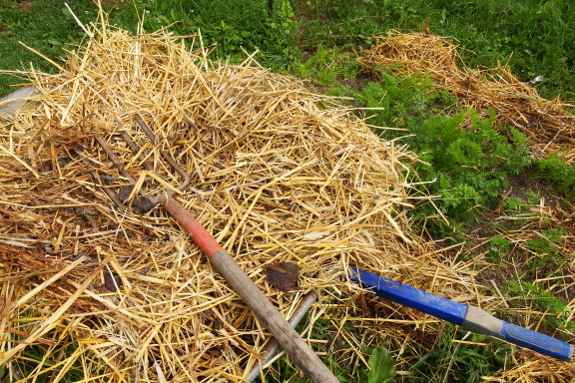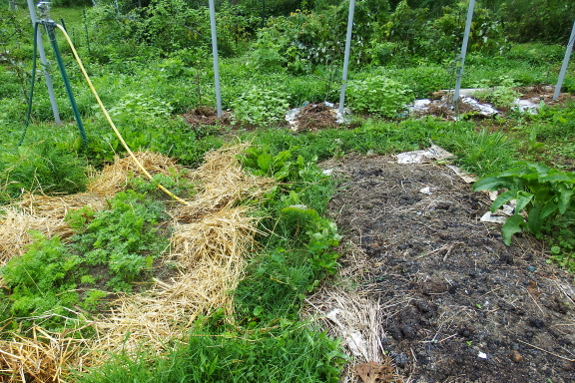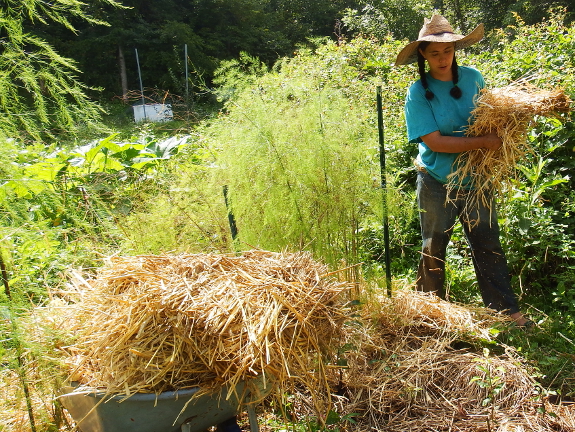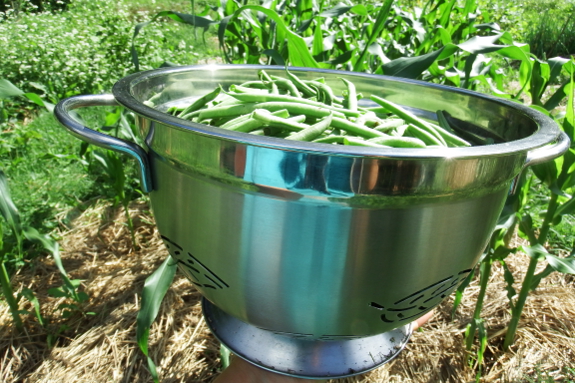
Using (almost) fresh manure on the garden

This year, our garden has
subsisted on 95% homegrown manure. This was more of an access issue
than a planned experiment, so I ended up behind and unable to compost
the bedding before application. I needed that fertility now rather than later.
As you might expect, my
results have been affected by that shortcut --- I figure we're at about
75% productivity compared to previous years when I fed the garden well-composted horse manure.
But we're finally caught up, so winter bedding will be composted and
hopefully next year we'll be back up to speed. And, just think,
homegrown manure means 70% less hauling work, 80% fewer weed invasions,
and 100% more control --- a definite long-term plus for our farm!

Interestingly, there have
been some areas in which the uncomposted goat bedding trumped
well-composted horse manure. My plan over the summer has been to apply
the goat bedding two weeks to one month before planting to ensure there
wouldn't be any seedling burn from fresh urine and goat berries. Then,
if I was planting something large (like sweet corn), I raked back the
manurey straw when I was ready to make planting furrows. If I was
planting something smaller like carrots, I raked all of the bedding to
the side of the bed, to be pulled back up around seedlings once they
sprouted.
The photo above shows two
beds planted with carrots on the same day. The bed on the right was
topdressed with the last of my stockpiled, well-rotted horse manure. The
bed on the left was treated as explained in the last paragraph with
goat bedding. I had almost zero germination in the horse manure bed,
which has been a common problem in previous years when getting the fall
garden going --- small seeds fail to sprout during dry spells, despite
what seems to be sufficient irrigation. So perhaps putting horse-manure
compost on the surface was the issue all along. I assume the compost
sucked up water and made the beds drier on the surface since the bed
next door sprouted quite well. In contrast, goat manure on top of the
soil kept the ground moist until planting day, then didn't get in the
way of seedling germination since I raked the straw to one side.

For new annuals, it's
pretty easy to incorporate a waiting step between bedding application
and plant growth. But what about when fertilizing perennials who are
already in place? I was a bit leery when topdressing fresh goat bedding around our strawberries and asparagus, but I ended up seeing fewer issues than expected. The strawberries, actually had no
complaints, presumably since there was already a layer of straw beneath
the goat bedding to sop up any high-nitrogen effluent that floated down
toward the ground. The asparagus was a bit less pleased, with the
youngest fronts showing wilting of the top four inches or so, a clear
sign of nitrogen burn.
Since my test asparagus
beds showed issues with the straight goat bedding, I'm now trying out
plan B on my other asparagus planting. I laid down a section of
newspaper (for weed control), then a healthy layer of fresh straw (to
buffer the nitrogen), then Mark and I scattered chicken manure from the
spring brooder lightly over top. Hopefully the nitrogen will be more
asparagus-friendly by the time it reaches the asparagus root zone this
time around.

The other good news on
the manure front is that most of our garden soil is now so good that
we're moving out of the renovation stage and into the maintenance stage,
meaning that some crops don't need pre-planting doses of manure at all.
We no longer feed our beans or peas, and in certain beds I also skip
feeding before planting leafy greens. I'm actually starting to imagine a
time when the composted manure from two goats, a flock of layers and an
annual round of broilers, plus the contributions of our composting
toilet will provide more fertility than our farm needs. What a change
from the eroded soil that required truckloads of manure before anything
would grow at all!
Want more in-depth information? Browse through our books.
Or explore more posts by date or by subject.
About us: Anna Hess and Mark Hamilton spent over a decade living self-sufficiently in the mountains of Virginia before moving north to start over from scratch in the foothills of Ohio. They've experimented with permaculture, no-till gardening, trailersteading, home-based microbusinesses and much more, writing about their adventures in both blogs and books.
Want to be notified when new comments are posted on this page? Click on the RSS button after you add a comment to subscribe to the comment feed, or simply check the box beside "email replies to me" while writing your comment.
